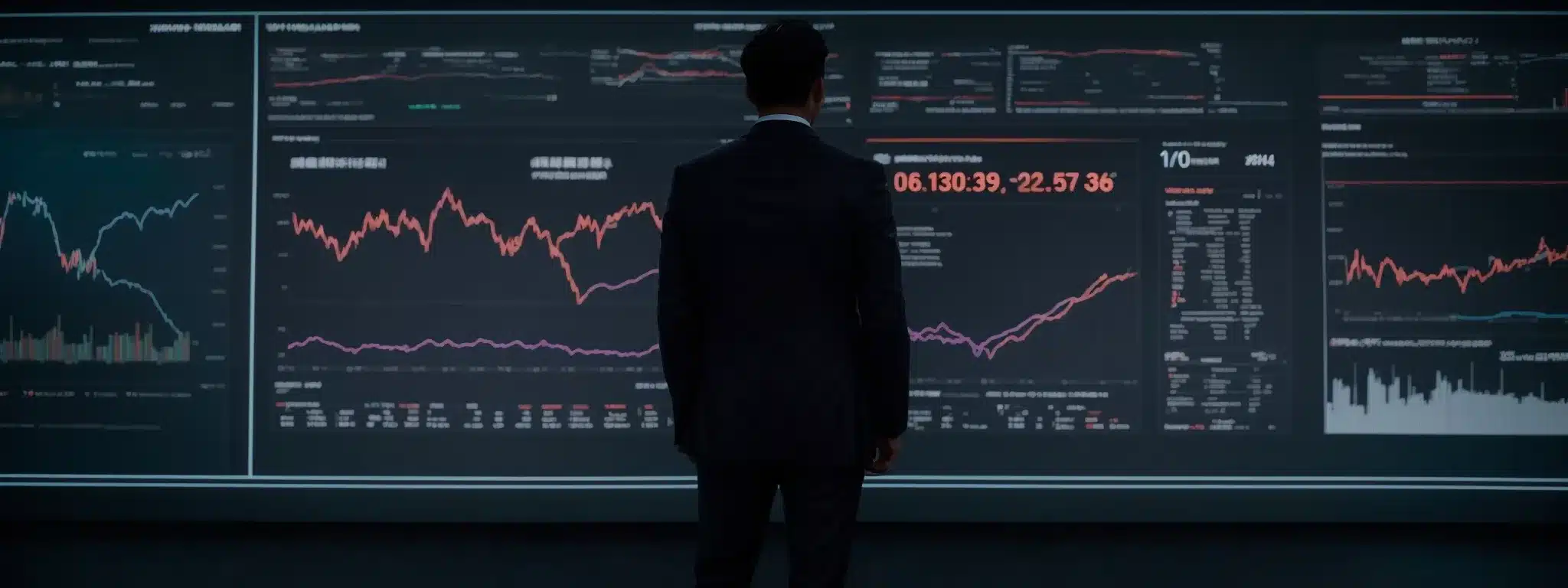
Mastering Competitive Analysis to Craft Winning Market Strategies
Imagine you’re a mighty explorer setting sail on the vast sea of commerce, your company’s ship bristling with the flags of ambition.
But beware, the waters are teeming with rival vessels, each vying for their share of treasure.
Here’s where competitive analysis is your trusty compass; it guides you through the choppy market dynamics, reveals the strengths and weaknesses of your adversaries, and illuminates the paths to untapped market opportunities.
Crafting a smart, savvy strategy becomes a thrilling quest to claim your rightful territory in the bustling market bazaar.
Keep your eyes peeled as you unfurl the map to navigate these complex trade winds and reach the coveted land of market dominance.
Keep reading to embark on this grand adventure, where the spoils of victory await the well-prepared navigator.
Key Takeaways
- Competitive Analysis Is Key to Understanding and Outmaneuvering Rival Business Strategies
- Setting Clear Business Goals Is Crucial for Guiding Marketing Efforts and Achieving Market Leadership
- Diverse Tools, Including Social Listening and Customer Feedback, Are Essential for a Thorough Understanding of the Competitive Landscape
- Adapting to Industry Trends Is Necessary for Creating Effective Marketing Strategies That Resonate With Customers
- Regular Competitive Audits and Agility in Strategy Are Vital for Long-Term Success in a Constantly Changing Market
Understanding Competitive Analysis in Market Strategy Development

Imagine yourself as a detective, dear reader, tasked with the quest of unraveling the secrets of market dominance.
Your magnifying glass?
Competitive analysis.
This indispensable tool is the Sherlock Holmes of marketing, allowing you to deduce your rivals’ strengths, anticipate their next moves, and illuminate your path to victory.
By defining competitive analysis within the marketing arena, we’re not just talking about keeping an eagle eye on your adversaries; we’re building a framework to understand their every gambit.
You’ll sieve through the market’s sediment to find golden data nuggets about your competitors, decoding the DNA of their business strategies.
As we delve deeper, we’ll identify the burgeoning buds of a competitive analysis: What are the moving parts of this machinery?
How do they mesh together?
Most crucially, we’ll discover why this endeavor is far more than academic—it’s the cornerstone upon which you can sculpt a marketing strategy that stands tall, unshakable by industry tremors and trend tempests alike.
So, buckle up and let’s embark on this intellectual joyride to carve a niche in the battleground of brands and win the hearts of customers, one insightful strategy at a time.
Define Competitive Analysis in the Context of Marketing
Think of competitive analysis as the deep-sea diving gear that lets you plunge into the ocean of your market: It equips you with the means to explore the mysterious depths where your competitors’ secrets lie in wait. It’s not simply a peek into their backyard; it’s an in-depth study, a plunge into the very heart of their strategies, strengths, weaknesses, and more. Mastering this analysis empowers you to shape a marketing strategy with the precision of a master sculptor.
- Peer through the marketing telescope to spot competitor movements.
- Decipher their code; what makes their business tick?
- Use your findings to fortify your marketing fortress.
Identify Key Components of a Competitive Analysis
You, my savvy investigator, will soon grasp that the core of competitive analysis is akin to assembling a complex puzzle. Each piece—a SWOT analysis here, a scrutinized market trend there—joins to form the grand picture of your industry’s battlefield. By recognizing these essential components you can anticipate every checkmate your rivals might dream up, adapting your strategy with the nimbleness of a marketing ninja.
Explore the Importance of Competitive Insight for Strategy
Picture yourself as the maestro of a grand orchestra, where every note is a piece of data and your baton guides the symphony of your market strategy. To strike the right chord with customers, you must be in tune with the rhythm of your rivals, and competitive insight is that harmonious melody. It’s the crescendo in your composition, turning a sea of noise into a masterpiece of market conquest.
Now, let’s lace up our detective shoes; it’s time to construct the blueprint of your success. Arm yourself with a competitive analysis framework that’ll make your rivals wish they were as savvy as you!
Crafting Your Competitive Analysis Framework

Stepping into the arena of competitive analysis, you’re like an architect ready to draft the blueprint of triumph.
This isn’t child’s play; it’s a strategic art.
Before you take flight on this journey, it’s pivotal to sketch out your battle plan.
Set clear goals as if you’re marking X on a treasure map; choose your tools with the discernment of a master craftsman; and establish your criteria for evaluating competitors like a judge at the grandest of culinary showdowns.
These prep steps are your foundation stones, ensuring that when you start to build, each brick slots in place with the confidence and precision of a winner’s smile.
Set Clear Objectives for Your Competitive Analysis
Before you sail the competitive seas, charting your route to triumph requires clear goals: They serve as your North Star, guiding efforts and illuminating the murky waters of the business ocean. Consider your objectives the rallying cry that marshals your entire crew—stakeholders, marketing mavens, and product pioneers—to hone in on what matters most: understanding rivals and navigating toward market leadership with unwavering focus and strategic precision.
- Define the scope of your competitive quest: who are these market moguls you’re up against?
- Chart the course to discern what customer treasures they’ve unearthed: how do they satisfy those sought-after customer needs?
- Sniff out the trade winds—identify trends and buying patterns influencing the tides within your industry.
Choose the Right Tools and Methods for Data Collection
Arm yourself with a digital Swiss Army knife of sorts; select social listening tools for a symphony of sentiment analysis, wield your survey-spear for piercing through layers of customer preferences, and launch interviews like exploratory rockets to gather rich, qualitative data. Your arsenal should be as diverse and precise as the instruments in a surgeon’s kit, employed to ensure no competitor’s whisper or customer sigh goes unnoticed.
Establish Criteria for Evaluating Competitors
Now, charting the course of your rivals requires you, as market strategy’s savvy cartographer, to set benchmarks that shine like stars in night’s sky. Laying down the gauntlet on factors such as market share, product innovation, and brand messaging, you’ll measure their might in the arena. It’s akin to picking the right lens for your telescope before gazing at the stars; only with the right criteria can you clearly see which competitors sparkle with success and which are dimming away.
With our competitive analysis framework firmly in hand, it’s time to turn our gaze outward. We’re set to dissect the offerings of our rivals, seeking that elusive market edge.
Analyzing Competitor Offerings for Market Edge

Welcome aboard, intrepid strategist!
Picture this: you’re the maestro gearing up to outplay every other musician in this symphony of market rivalry.
It’s time to fine-tune your instruments, and the notes you seek to master are your competitors’ offerings.
As your grand odyssey unfolds, you’ll dissect the anatomy of competitor products, parsing through their features and benefits with the incisiveness of a seasoned surgeon.
Then, with the precision of an artisan, you’ll examine the labyrinth of their pricing strategies and nudge your way onto the top shelf of market position.
Not one to rest on your laurels, you’ll also decode the enigma of their marketing and promotion antics—after all, knowledge is your currency in this marketplace, and you, my friend, are investing wisely.
Prepare to unfurl the sails; a journey of discovery awaits as you steer your enterprise into the uncharted waters of competitive advantage.
Break Down Competitor Product Features and Benefits
Step onto the stage as your marketplace’s maestro, where every competitor’s product is a note to be played in your symphony of strategy. Dissecting their offerings is like peeling an onion: Layer by layer, reveal the core features that draw tears of joy or frustration from your customers. By understanding the benefits that rival products tout, you twirl your conductor’s baton, orchestrating a dynamic response that amplifies your market presence:
- Examine their product’s bells and whistles: what turns the customer’s head?
- Assess the promises they whisper in the market’s ear: are those benefits the siren’s song?
- Chart their allure: how does it dance with customer desires?
Assess Competitor Pricing Strategies and Market Position
Ah, the art of monetary maneuvering and the chessboard of market hierarchy—your ability to decode your competitor’s pricing rhythm and market standing is as crucial as a lighthouse in the foggy night of retail. Sharpen your pencil, dear strategist, for this leg of your quest looks squarely at the digits and decimals that define your rivals’ worth. Your task: to grasp their pricing plot and spot where they perch on the industry’s totem pole, thus arming your business with the intel needed to price like a pro and position with panache.
Evaluate Competitor Marketing and Promotion Tactics
Now, dear strategist, turn your gaze to the high-stakes game of thrones playing out in the promotional arenas. Dissecting your competitor’s marketing and promotion tactics is like being the savvy critic at a movie premiere: you watch, you scrutinize, and you discern the plot twists of their campaign sagas. From the whispering allure of influencer collaborations to the roar of social media campaigns, you need to grasp the narrative they’re spinning: Are they casting a wide net or targeting with the precision of a hawk?
- Scrutinize the star-studded cast of influencers and partnerships: who’s being enlisted to tell their tale?
- Examine the pulse of their social media content: does it quicken the heartbeat of their audience?
- Uncover the story arc of their marketing campaigns: what’s the hook that keeps customers coming back for more?
We’ve unlocked the secrets behind our competitors’ strategies, but the treasure map isn’t complete without the X that marks the spot. It’s time to chart the currents of the market’s ocean, uncovering the trends that guide the ships of success.
Identifying Market Trends Through Thorough Analysis

Ever feel like a master chef trying to predict the next big flavor craze?
Well, stepping into the realm of market trends is not all that different.
Your kitchen is the bustling world of industry shifts and consumer whims, and to cook up irresistible marketing strategies, you must have your finger on the pulse of the latest fads.
You’re about to don your detective hat, transforming streams of data into actionable insights.
Whip out your binoculars, for it’s time to scan the horizon of industry reports and dive into the sea of market research.
Get ready to prick up your ears with social listening tools and keep your notepad at hand for scribbles of customer feedback.
These are your secret ingredients for detecting the patterns and preferences that will inform your standout market concoction.
Monitor Industry Reports and Market Research for Trends
Step right up, intrepid trend-spotter, and ready those spectacles for the main event: the grand circus of industry reports and the sea that is market research. Like a hawk perched high above the fray, your eyes must scan far and wide, sifting through layers of data and insightful dispatches to capture the swiftest of market trend transformations in your talons: those make-or-break insights that separate market leaders from the lost crowd of followers.
- Transform into the Indiana Jones of data, venturing into the thick jungle that is market research.
- Keep a keen edge on your analysis sword, slicing through industry report gibberish to carve out crystal clarity on where the market pulses truly lie.
- Be the savvy miner, sieving the streams of consumer feedback to unveil nuggets of trend gold that will enrich your strategy.
Leverage Social Listening for Real-Time Trend Insights
Imagine you’re the captain of a ship on the watchtower, scanning the vast ocean waves for signs of change. As you leverage social listening tools, you become attuned to the whispered dialogues and resonant shouts of the market arena, catching glimpses of the interactions that shape consumer landscapes. It’s the digital equivalent of an ear pressed to the ground, providing real-time insights with the finesse of an expert stargazer interpreting the night sky — so you know exactly which way the tide is turning.
Utilize Customer Feedback to Detect Emerging Patterns
As the savvy maestro of market melodies, don’t you dare underestimate the symphonic power of customer feedback. It’s the rhythmic clapping or booing that guides the tempo of your next big hit: Spotting patterns in feedback is akin to a musician tuning into the audience’s vibe, ensuring your next performance gets a standing ovation.
- Glean the storylines woven through customer reviews—what plot twists are delighting or disappointing your audience?
- List the encore demands: What features are getting rave reviews and encore chirps in the feedback?
- Chart the off-key notes: where do customer gripes tell a tale of missed expectations or opportunities?
Having unearthed the hidden rhythms of the market, we stand poised on the precipice of strategic transformation. It’s time to weave these trends into the very fabric of our planning tapestry.
Integrating Trend Analysis Into Strategic Planning

Welcome to the grand tapestry of strategic planning, where adjusting the threads of emerging market currents can create a majestic masterpiece.
Like a chess grandmaster poised before the board, you must align each market trend meticulously with your business goals and objectives.
Adapting your product offerings isn’t just a whimsical change of pace—it’s a calculated dance with the future, a foxtrot of forecasting that can launch your creations to the front of the line.
And what about those marketing campaigns?
Infuse them with the fresh zest of trend insights, and watch how they effortlessly resonate with the hearts and minds of your audience.
Together, let’s weave these threads into a strategy that not only stands out but also stands the test of time!
Align Market Trends With Business Goals and Objectives
Steer your ship by the stars of market trends and align them with the compass of your company’s aspirations. Let every market whisper nudge your sails closer to the land of your business objectives, crafting a pathway where product innovation meets the tidal forces of consumer demand. You’re not just surfing waves here; you’re aligning the celestial bodies to form a constellation that points directly to success.
Adapt Product Development Based on Trend Forecasting
Embark on a whimsical wizardry of product evolution, where trend forecasting is your crystal ball, guiding the transmutation of today’s goods into tomorrow’s treasures. By adapting your product development to the rhythm of market prophecies, you are like a savvy alchemist turning base materials into golden delights that the market didn’t even know it was craving.
Optimize Marketing Campaigns Through Trend Insights
Think of trend insights as your marketing campaign’s secret sauce, a dash of which can transform bland outreach into a gourmet feast for your target audience’s attention. As you deftly infuse these savory trends into the broth of your marketing efforts, each message you send out becomes more tantalizing, more irresistible—like a whiff of freshly-baked bread luring customers straight to your door. By masterfully balancing the flavors of consumer buzz, your campaigns will not only be a hit but a showstopper that has your competition watching from the sidelines with envious eyes.
Armed with the insights from trend analysis, the stage is set for a strategic masterstroke. It’s time to leap into the fray, outsmarting rivals with tactics they never saw coming.
Outmaneuvering Competitors With Actionable Strategies

Picture yourself as a maestro of market strategy, conducting an orchestra of unique propositions and ingenious tactics to outshine your competitors.
Crafting a potent elixir of Unique Selling Propositions (USPs), stirring the cauldron of marketing mix strategies, and fine-tuning the dials of dynamic pricing models, you’re all set to cast a spell of dominance in the marketplace.
It’s time to weave together these strategic threads with the finesse of a grandmaster playing a high-stakes game of chess; clever moves that ensure the king—your business—remains a step ahead of challengers.
So, with a wily grin and strategy up your sleeve, prepare to unveil the secrets that will turn your competitors’ strengths into mere shadows of your forthcoming triumphs.
Formulate Unique Selling Propositions (USPs) Against Rivals
Imagine yourself as a crafty sculptor, chiseling away at the stone of competition until you reveal the stunning figure of your brand’s USP. Carve out a distinctive edge in the tapestry of commerce, where your product’s unparalleled enchantment compels customers to flock to your door as if drawn by the Pied Piper’s tune. Your endgame? To ensure that when customers hear your brand’s name, it’s akin to a siren’s call, irresistible and singular in a sea of sameness.
Develop Competitive Marketing Mix Strategies
Picture yourself as a maestro concocting a potion of market magic, mixing each element of product, price, place, and promotion with the dexterity of a seasoned bartender. Developing a competitive marketing mix strategy is your display of mixological expertise: blending the core components sufficiently to set the bar high and leave the competition tipsy with envy. It’s about mastering the cocktail of success, leaving a taste in consumers’ mouths that’s as memorable as it is strategic:
- Craft a product recipe that has your target audience’s taste buds tingling with anticipation.
- Stir up a pricing strategy that undercuts your rivals while padding your product’s perceived value.
- Whisk your brand into places that elevate its presence, out of competitors’ shadows.
- Shake up promotion tactics that echo across the marketplace like the shout of a herald.
Implement Dynamic Pricing Models for Competitive Advantage
Now, imagine you’re the savvy shopper in the bazaar of business, where every price tag is subject to the artful haggle of demand. Implementing dynamic pricing models allows you to bob and weave through the ebbs and flows of market demand with the agility of an acrobat, always landing on the sweet spot of profitability. You adjust prices on the fly, your goods pirouetting on the customer’s wallets with the grace of a prima ballerina – all to gain that competitive high ground.
- Match your pricing to the heartbeat of market demand: Speed up or slow down with the pulse of your audience’s needs.
- Swing the pendulum of prices with the precision of a metronome, ensuring each tick resonates with opportunity.
- Channel your inner market maestro, orchestrating pricing that sings in perfect harmony with customer expectations and wallet widths.
Buckle up as our marketing chess game evolves! Watch how our strategic moves shake up the board and redefine winning.
Measuring the Impact of Your Market Strategy on Performance

So, you’ve brandished your marketing sword and mapped your journey through the competitive wilderness, but how will you know if you’ve conquered new lands or merely marched in place?
Enter the mighty realm of measurement, where Key Performance Indicators (KPIs) serve as your loyal scouts, reporting back on the effectiveness of your strategies.
You’re the commander assessing your battleground—analyzing the resources invested in acquiring new customers, appreciating their life’s worth to your empire, and keeping a vigilant watch on your territorial expansion and the richness of your brand’s reputation.
Your strategy may be a masterpiece, but only by measuring its impact can you truly paint a picture of victory.
So, ready your ledger and let’s quantify your triumphs!
Define Key Performance Indicators (KPIs) for Strategy Effectiveness
Think of Key Performance Indicators (KPIs) as your personal squadron of drones, buzzing over the battlefield of business; they’re on a reconnaissance mission, capturing intel that’s crucial for appraising the might of your market maneuvers. By establishing these KPIs, you’re essentially choosing the scoreboard by which you’ll judge the Olympian feats of your marketing strategy—transforming raw performance data into the laurels upon which your company’s success can proudly rest.
Analyze Customer Acquisition Costs (CAC) and Customer Lifetime Value (CLV)
Embark on a financial voyage, my astute strategists, where you’ll weigh the coins it takes to woo new patrons—your Customer Acquisition Costs—against the treasure trove they promise over time—their Customer Lifetime Value. These two financial beacons will light your way through foggy marketing seas, guiding you to calmer waters where the investment in a customer isn’t a gamble, but a meticulously calculated bet with a generous return. Trust that by analyzing these metrics, you can fine-tune your siren songs of acquisition, ensuring they resonate with an audience who won’t just pass through but will anchor their loyalty in your harbor for years to come.
Track Market Share Growth and Brand Equity Changes
Set your sights on the coveted throne of market share; it’s a number that mirrors your brand’s kingdom of influence. Keep a close watch, as gaining ground here whispers tales of your growing prowess among customers. Meanwhile, tend to the garden of your brand equity, where each bloom of recognition and recall is worth its weight in gold, signaling that your brand story resonates in the marketplace much like a bard’s tale in a crowded tavern — memorable and retold.
Hold on to your hats, because the ride isn’t over yet! Up next, we dive headfirst into the thrill of perpetual strategy refinement.
Continuously Refine Strategies Through Ongoing Analysis

Behold, fellow strategy sculptors, the intricate dance of strategic evolution.
As you stand vigil in the ever-shifting sands of the marketplace, remember: adaptation is the secret spell for enduring success.
Crafting your competitive analysis is not a ‘one-and-done’ enchantment, but rather, it’s a vibrant spellbook that requires continuous updates.
Imagine yourself in an intricate masquerade of moves and countermoves, where staying light on your feet, with an ear to the ground, can mean capturing the crown or just fading into the crowd.
Let’s unfurl the scrolls of wisdom and etch a routine of regular competitive audits, polish the mirror of feedback loops for sparkling strategy refinements, and keep the potion of agility at hand to morph with the mercurial moods of the market.
Join me in navigating this journey where strategy isn’t just set in stone—it’s alive with perpetual reinvention.
Establish a Routine for Regular Competitive Audits
Consider the art of the regular competitive audit as your strategy’s annual health check-up, ensuring your business stays in prime fighting form. It’s akin to a filmmaker reviewing dailies; by keeping a routine eye on your market rivals, you stay ahead of the script, preempting their blockbuster moves with your indie flick prowess. So mark your calendar, and make these audits as habitual as morning coffee – your future self, brimming with market insights, will thank you.
Utilize Feedback Loops to Improve Strategic Decisions
Embrace the clever choreography of feedback loops, where each observation from your audience is a golden step in the dance of decision-making. By tuning into the applause and murmurings of your customers, you’re not just gathering opinions; you’re sharpening your marketing strategies like a chef hones a prized knife, ensuring your next slice in the market is both deft and decisive. Think of it as an ever-spinning compass, perpetually guiding your business ship through the strategic high seas towards triumphant shores.
Stay Agile to Adjust Strategies in Response to Market Changes
Consider yourself a nimble navigator of the corporate seas, where each wave of market change demands a deft turn of the sails. In the spirited dance of commerce, agility is your partner, twirling your strategies with such elegance that market shifts only add flair to your step. And as you pirouette through the unexpected, your competitors’ plodding can’t begin to compete with your capacity for quick-stepped innovation.
 Skip to content
Skip to content





